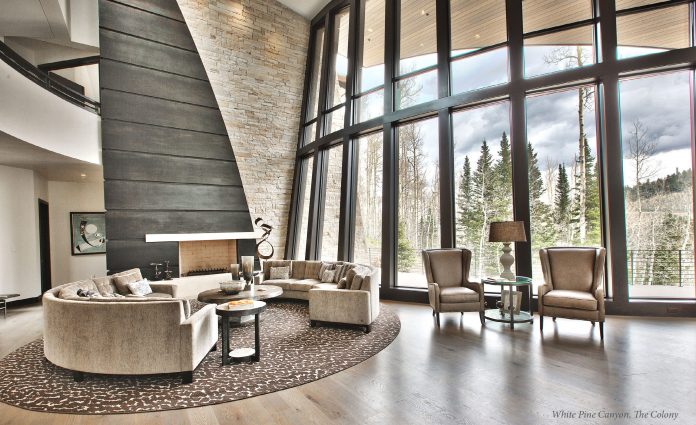By Ann Zimmerman
Extra attention to architectural detailing and focusing on the right accessories, pop contemporary mountain home design.
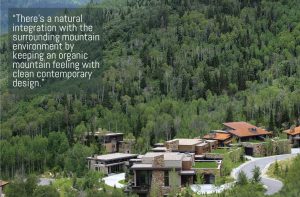 Contemporary mountain home design has captured the spirit of many in Park City, and it’s clearly how they want to live. Some of these homes just seem to nail the feeling of clean sleek lines and a touch of warm natural elements. We asked some local experts about how this look is achieved, and how extra attention to detailing and accessories make these designs spectacular.
Contemporary mountain home design has captured the spirit of many in Park City, and it’s clearly how they want to live. Some of these homes just seem to nail the feeling of clean sleek lines and a touch of warm natural elements. We asked some local experts about how this look is achieved, and how extra attention to detailing and accessories make these designs spectacular.
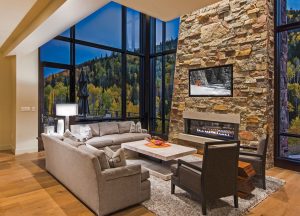 Negar Chèvre-Shams with Berkshire Hathaway HomeServices keeps a close eye on the Park City market and has watched the preferred building style move to mountain contemporary. She also has the opportunity to speak with a number of potential Park City buyers in her role representing the Enclave at Sun Canyon. “There’s a natural integration with the surrounding mountain environment by keeping an organic mountain feeling with clean contemporary design,” she remarks, offering examples in the Enclave’s design where organic elements like stone and wood add a timeless mountain look in a home with floor to ceiling windows. “It’s important these designs clearly state that it is a home in the mountains, and not somewhere else like South Beach or Manhattan.”
Negar Chèvre-Shams with Berkshire Hathaway HomeServices keeps a close eye on the Park City market and has watched the preferred building style move to mountain contemporary. She also has the opportunity to speak with a number of potential Park City buyers in her role representing the Enclave at Sun Canyon. “There’s a natural integration with the surrounding mountain environment by keeping an organic mountain feeling with clean contemporary design,” she remarks, offering examples in the Enclave’s design where organic elements like stone and wood add a timeless mountain look in a home with floor to ceiling windows. “It’s important these designs clearly state that it is a home in the mountains, and not somewhere else like South Beach or Manhattan.”
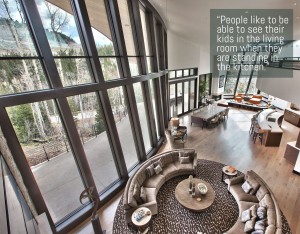 Agreeing, Ross Brookham, Marketing Manager and Real Estate Advisor at Engel & Völkers, says, “Yes, the consumer demand is for mountain contemporary and by far it is the most sought after home. One of the reasons it works so well in a mountain environment is that homes look over the Wasatch Mountains, skiing, and beautiful golf courses, and the large windows allow these views to come into the homes. Park City’s unique developments can allow for maximizing glass on the view sides while still retaining privacy from neighbors, such as on the mountainside of Deer Crest or the large lots in the Colony. I think the openness and connectedness of the interior is important, too. People like to be able to see their kids in the living room when they are standing in the kitchen.”
Agreeing, Ross Brookham, Marketing Manager and Real Estate Advisor at Engel & Völkers, says, “Yes, the consumer demand is for mountain contemporary and by far it is the most sought after home. One of the reasons it works so well in a mountain environment is that homes look over the Wasatch Mountains, skiing, and beautiful golf courses, and the large windows allow these views to come into the homes. Park City’s unique developments can allow for maximizing glass on the view sides while still retaining privacy from neighbors, such as on the mountainside of Deer Crest or the large lots in the Colony. I think the openness and connectedness of the interior is important, too. People like to be able to see their kids in the living room when they are standing in the kitchen.”
ARTFUL DETAILING
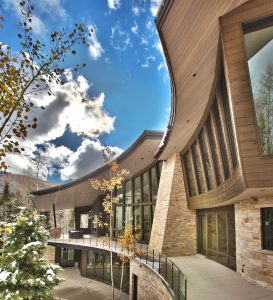 Rick Otto and Mark Walker are partners at Otto/Walker Architects in Park City, and they have designed many of Park City’s mountain homes, including designs that reflect the current local aesthetic, which Walker describes. “The lines are very straight, and there are right angles. It is simple and straightforward, uncluttered, and unobstructed. Materials are most frequently stone, wood, and glass. There are flat and shed roofs and large cantilevered overhangs.”
Rick Otto and Mark Walker are partners at Otto/Walker Architects in Park City, and they have designed many of Park City’s mountain homes, including designs that reflect the current local aesthetic, which Walker describes. “The lines are very straight, and there are right angles. It is simple and straightforward, uncluttered, and unobstructed. Materials are most frequently stone, wood, and glass. There are flat and shed roofs and large cantilevered overhangs.”
Otto adds, “Wood and stone are traditional in mountain architecture, but the difference in today’s designs is how you use it. We stack ledger stone for a layered, clean feel in contrast to the past with more rustic designs, where stone was mounted flat against surfaces. Similarly, wood is used in clean, simple shapes. Additionally, we use metals on the exterior like corten steel, which is rusted for a warm color and zinc panels. We’ve never used zinc before, but it has a consistent patina and dark colors that work well with our designs.”
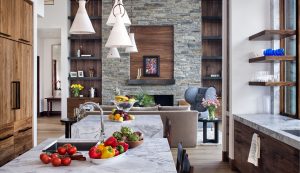 Walker characterizes the interiors of this style as transparent, featuring open plans and spaces that are clean with contemporary detailing, but most of all, generous glass and windows. “The architecture is more evident because it shows off the plan and the flow, and ceiling heights are exposed and emphasized.”
Walker characterizes the interiors of this style as transparent, featuring open plans and spaces that are clean with contemporary detailing, but most of all, generous glass and windows. “The architecture is more evident because it shows off the plan and the flow, and ceiling heights are exposed and emphasized.”
When asked how the architecture achieves the look of being simple and restrained, Otto offers some examples. “An example is base and case. In traditional mountain design, these are exposed wood, which draws the eye to the trim. If it is painted the color of the wall, it goes away to the eye. In some cases, we have eliminated trim. What we want to accomplish is to draw the eye to the view and beyond. The result is a home that resonates fresh and streamlined.”
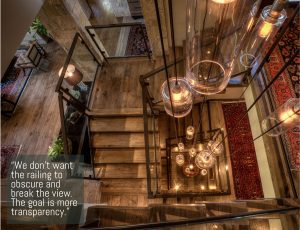 “Similarly, we use glass in railings or in combination with metal,” Otto adds, “because we don’t want the railing to obscure and break the view. The goal is more transparency.”
“Similarly, we use glass in railings or in combination with metal,” Otto adds, “because we don’t want the railing to obscure and break the view. The goal is more transparency.”
“But the home has to feel that it is still in the mountains,” states Walker. “That’s critical. Wood, glass, and stone in combination can accomplish this. We design timeless homes that stay relevant over time without gimmicks or trends that date them, and this necessitates always maintaining a sensitivity to the mountain location.”
Paula Berg, owner of Paula Berg Design in Park City, offers her take on designing architectural details. “There are cleaner lines, and we are refining textures and the use of natural materials, such as using steel on railings and fireplaces. For wood we are no longer using knotty alder, but instead something more refined like rift oak and smooth finishes, and in some cases we are substituting melamine in cabinets for natural wood. Wall finishes are cleaner, as well, with no faux finishing—just plain paint with the addition of textured wall finishes for accent areas. We are also paying attention to simpler finishes on structural details. An example is leaving raw beams or exposed steel instead of boxing beams.”
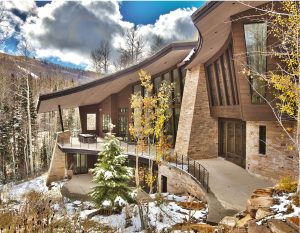 In a recent Deer Valley project featured in the Showcase of Homes, designers Carolyn Davis and Susan Minard of San Francisco Design in Park City sought the balance between clean and organic architectural detailing. “We finished one wall with barn wood that was planed smooth and painted the surface behind the wood black,” describes Davis. “The result was a clean and precise application of old natural wood. In the bathrooms, we continued the tile from the floor to the ceiling so the eye doesn’t stop to achieve that uncluttered look.
In a recent Deer Valley project featured in the Showcase of Homes, designers Carolyn Davis and Susan Minard of San Francisco Design in Park City sought the balance between clean and organic architectural detailing. “We finished one wall with barn wood that was planed smooth and painted the surface behind the wood black,” describes Davis. “The result was a clean and precise application of old natural wood. In the bathrooms, we continued the tile from the floor to the ceiling so the eye doesn’t stop to achieve that uncluttered look.
FEW BUT STRONG ACCESSORIES
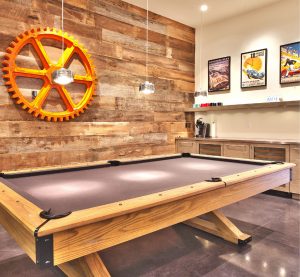 Paula Berg approaches accessorizing a mountain contemporary home very differently than with previous mountain designs. “It’s important to leave more space and not feel that you have to fill every shelf or corner and to allow the house to breathe. Instead of filling shelves with clutter, take a more deliberate approach and place things like sculpture and glass on the shelves.” She also likes to combine metals such as nickel and gold finishes, and to use a variety of textures in the metal.
Paula Berg approaches accessorizing a mountain contemporary home very differently than with previous mountain designs. “It’s important to leave more space and not feel that you have to fill every shelf or corner and to allow the house to breathe. Instead of filling shelves with clutter, take a more deliberate approach and place things like sculpture and glass on the shelves.” She also likes to combine metals such as nickel and gold finishes, and to use a variety of textures in the metal.
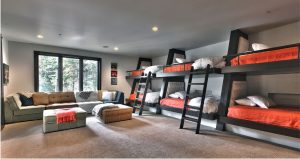 “Clients no longer want the dark, rustic cabin look,” says Summer Hatch, an interior designer who works at Details, a stylish Salt Lake retail store. “Instead, our clients prefer a happy and light space with rustic-modern touches. They want clean-lined furniture pieces with a rugged- inspired look.” She adds that materials that work well with these designs are leather, mohair, and boiled wool. Wood appears in a mix of textures from natural to barn wood. She observes that contemporary art pieces are replacing Western. When asked about rugs, she says, “For mountain modern homes, contemporary tribal rugs with geometric patterning work exceptionally well.”
“Clients no longer want the dark, rustic cabin look,” says Summer Hatch, an interior designer who works at Details, a stylish Salt Lake retail store. “Instead, our clients prefer a happy and light space with rustic-modern touches. They want clean-lined furniture pieces with a rugged- inspired look.” She adds that materials that work well with these designs are leather, mohair, and boiled wool. Wood appears in a mix of textures from natural to barn wood. She observes that contemporary art pieces are replacing Western. When asked about rugs, she says, “For mountain modern homes, contemporary tribal rugs with geometric patterning work exceptionally well.”
“Less is more. There is not as much clutter, and each piece is given more thought and makes a statement,” answers Anthea Hovden of Robert Kelly Home, when asked about accessories.
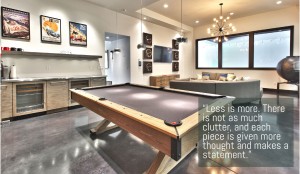 “In Park City, many people have homes elsewhere, and that’s where they keep personal or perhaps sentimental pieces,” Hovden continues. “Here they appreciate clean lines and are very sparse with accents and look for a singular eyecatching piece. Like lamps—often there is just the lamp on a table, and it is interesting and specifically selected for that place. Art selections are similar. There can be a single dramatic piece in a space empty of any other art that might compete with it.”
“In Park City, many people have homes elsewhere, and that’s where they keep personal or perhaps sentimental pieces,” Hovden continues. “Here they appreciate clean lines and are very sparse with accents and look for a singular eyecatching piece. Like lamps—often there is just the lamp on a table, and it is interesting and specifically selected for that place. Art selections are similar. There can be a single dramatic piece in a space empty of any other art that might compete with it.”
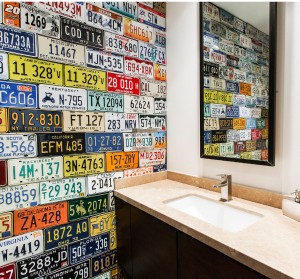 “Without the need to fill things up, the design draws more attention to the architectural elements like beams and barn wood walls or sliding doors,” Hovden explains. “The clean spaces on the inside also make you look outside, where there is so much going on. Neutral organic colors like tans, cream, and gray maintain the simplicity inside, and we introduce variety through variations in texture instead of by color. Color is outside and in the natural environment.”
“Without the need to fill things up, the design draws more attention to the architectural elements like beams and barn wood walls or sliding doors,” Hovden explains. “The clean spaces on the inside also make you look outside, where there is so much going on. Neutral organic colors like tans, cream, and gray maintain the simplicity inside, and we introduce variety through variations in texture instead of by color. Color is outside and in the natural environment.”
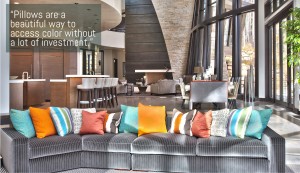 Carolyn Davis says she uses far fewer accessories than in the past. “I will use accessories to pop color or warm the space, and I find natural glass and metal adds a touch of detail but is not over the top. Lighting is really the jewelry of the home, and floor lamps with a nice, simple profile offer a lot
Carolyn Davis says she uses far fewer accessories than in the past. “I will use accessories to pop color or warm the space, and I find natural glass and metal adds a touch of detail but is not over the top. Lighting is really the jewelry of the home, and floor lamps with a nice, simple profile offer a lot
of presence, like those from Robert Abbey. Pillows are a beautiful way to access color without a lot of investment, so when someone tires of it, it’s easy to switch out. Another nice touch is fresh flowers weekly in either clear or colored vases with clean lines.”
RIGHT LIGHT
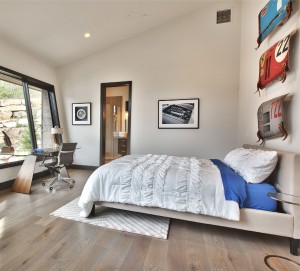 Windows provide transparency to Park City’s incredible views and keep the spaces bright and cheerful. However, high alpine sunshine can be overwhelming and requires keeping a good pair of sunglasses close by. For homes, blinds serve a similar function by controlling glare and controlling heat.
Windows provide transparency to Park City’s incredible views and keep the spaces bright and cheerful. However, high alpine sunshine can be overwhelming and requires keeping a good pair of sunglasses close by. For homes, blinds serve a similar function by controlling glare and controlling heat.
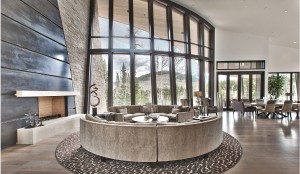 When asked about the window coverings of choice for contemporary mountain design, Tim Luger, long-time local and owner of Park City Blind & Design, says that roller shades are the most common selection. “It’s a clean, precise look and an uncluttered background for the room. We carry shades over ten feet in width, and we can couple shades to cover over 30 feet. They tuck away in a four-by-four-inch pocket.” For the sunglass effect of filtering light, Luger offers see-through mesh shades in a range of materials that includes fabric and wood fiber. “These can be used in conjunction with black- out blinds for privacy or to eliminate light.”
When asked about the window coverings of choice for contemporary mountain design, Tim Luger, long-time local and owner of Park City Blind & Design, says that roller shades are the most common selection. “It’s a clean, precise look and an uncluttered background for the room. We carry shades over ten feet in width, and we can couple shades to cover over 30 feet. They tuck away in a four-by-four-inch pocket.” For the sunglass effect of filtering light, Luger offers see-through mesh shades in a range of materials that includes fabric and wood fiber. “These can be used in conjunction with black- out blinds for privacy or to eliminate light.”
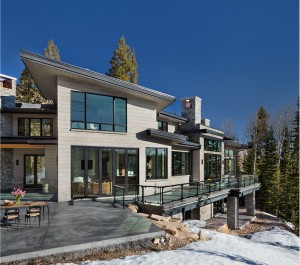 Roller shades benefit from new technologies, says Luger. “Motorized systems have improved and also have come down in price.” According to Luger, operation can be through many different automated systems that range from controllers to apps. Apps through devices like iPads and iPhones can be remotely operated by home automation systems, or they can be tied in with sensors to control the temperature and sunlight in the home by adjusting blinds. Park City Blind & Design displays products in their showroom, delivers, installs, and offers repair services.
Roller shades benefit from new technologies, says Luger. “Motorized systems have improved and also have come down in price.” According to Luger, operation can be through many different automated systems that range from controllers to apps. Apps through devices like iPads and iPhones can be remotely operated by home automation systems, or they can be tied in with sensors to control the temperature and sunlight in the home by adjusting blinds. Park City Blind & Design displays products in their showroom, delivers, installs, and offers repair services.
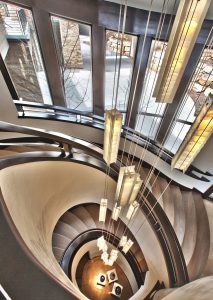 The right lighting is also key to a bright contemporary home. Miranda Saiz, a lighting specialist with Park City’s Elume Lighting notes, “The key is to provide an adequate amount of light without calling attention to the sources. There are ways to mute light so that it isn’t intrusive through baffles and reflectors and by picking the right-sized cans with attention to lumens and beam spread.”
The right lighting is also key to a bright contemporary home. Miranda Saiz, a lighting specialist with Park City’s Elume Lighting notes, “The key is to provide an adequate amount of light without calling attention to the sources. There are ways to mute light so that it isn’t intrusive through baffles and reflectors and by picking the right-sized cans with attention to lumens and beam spread.”
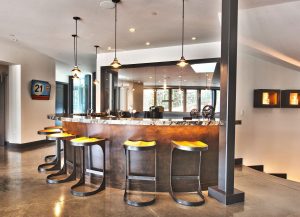 Saiz sees a difference in the past rustic lodge designs where the goal was a warm, almost moody feeling, and heavy, ornate fixtures put out golden light. “With mountain contemporary, the fixtures can be bronze or iron, but the shape is less ornate and the globes and bulbs emit a light that is closer to daylight in color. It’s easier to achieve daylight colors by using new LED products instead of fluorescent or incandescent bulbs, but even with LEDs, it’s important to select the right color.”
Saiz sees a difference in the past rustic lodge designs where the goal was a warm, almost moody feeling, and heavy, ornate fixtures put out golden light. “With mountain contemporary, the fixtures can be bronze or iron, but the shape is less ornate and the globes and bulbs emit a light that is closer to daylight in color. It’s easier to achieve daylight colors by using new LED products instead of fluorescent or incandescent bulbs, but even with LEDs, it’s important to select the right color.”
An exception Saiz observes is the occasional use of Edison bulbs, where the golden tones are used intentionally to warm the space and correspond to the transitional and mountain elements elsewhere in the design.
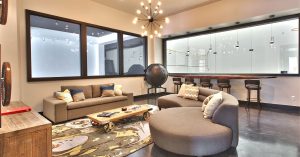 Mountain contemporary has captured today’s mood in Park City, and with some attention to the extras like architectural detailing, accessories, lighting, and shading, these homes can become even more spectacular and memorable.
Mountain contemporary has captured today’s mood in Park City, and with some attention to the extras like architectural detailing, accessories, lighting, and shading, these homes can become even more spectacular and memorable.

